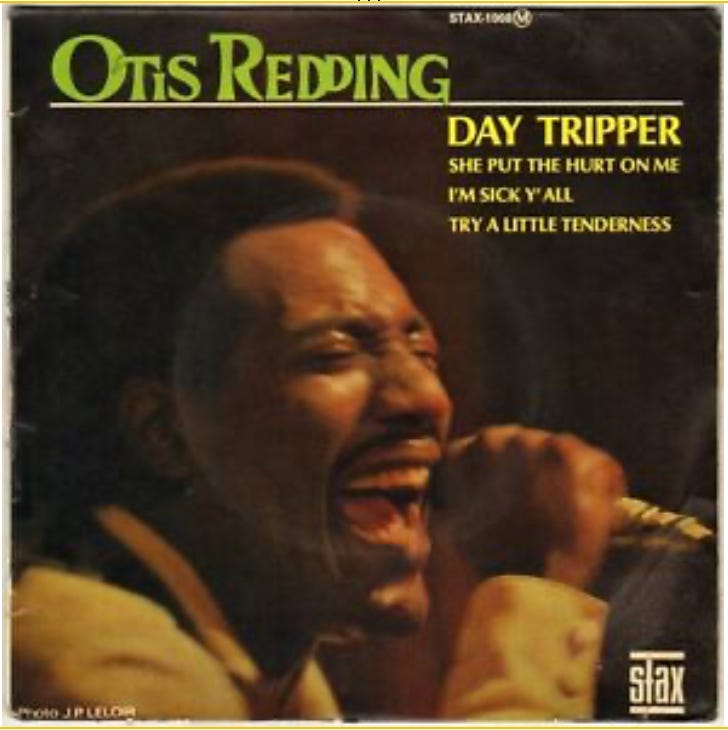Otis Redding Takes Lennon-McCartney For a Spin
How the Great Equation explodes when soulsters sing the Beatles
Keynote: Beatles 2000 Conference Jyväskylä, Finland, June 2000
When Jon Landau wrote that “Otis Redding Is Rock’n’Roll” in Crawdaddy, he meant that the emerging synthesis between rock, soul, country, R&B, and gospel felt both infinite and inevitable, full of “ecstacy and desperation.” Before the print could dry, Redding had died in a plane crash on December 10, 1967. History frames his death next to figures like Buddy Holly or Eddie Cochran, talents of epic promise whose contributions loom over the rest of the style. He brought a booming charisma to other people’s songs (“Satisfaction,” “Pain in My Heart”), and held out tempting original work (“Respect,” which roared back through Aretha Franklin). He would have turned 83 this week (born September 9, 1941).
LENNON AND MCCARTNEY songs now form so much a foundation of the pop firmament that we rarely question singers' motives in singing them anymore. The mere familiarity of a Beatles song can gain your attention the way few other songwriters can, and there will be catalogs devoted to discographies of "Yesterday" by so many Paul Ankas and William Shatners. And yet few covers ever compete with the band’s own recordings. Why is this so? Even with singers as great as Stevie Wonder, Ray Charles, and Aretha Franklin, who all covered Beatles songs, few would rate even these singers' versions above the original Beatles track.
Of course, the Beatles were themselves masters at covers, chiefly during their apprenticeship during their BBC appearances. I chronicled this as much as possible in Tell Me Why, and since 1988, we've added The Beatles at the Beeb, and the Royal Dane bootleg, The Complete BBC Sessions, to the source catalog. The Dane box is as detailed a map of their musical nervous system as you could sketch: here, the Beatles discovered their own ensemble and songwriting potential through a catalog of stylistic affections in other people's songs. It is in no small measure of their accomplishment that we now think of songs like The Isley Brothers' "Twist and Shout" and Chuck Berry's "Rock and Roll Music" at least as much Beatles' tracks as their writers'. These recordings do more than reveal new potential in the context of the emerging Beatles mythology: new young British voices adopting American sounds as building blocks of their emerging style and of rock's future. The best Beatles covers rival their originals by balancing an exquisite sense of tribute with poetic imitation: copying that goes far beyond imitation to uncover new layers of meaning, color, and texture in an otherwise static form. The Beatles took defining moments in rock and created tributes that became new defining moments.
The Beatles took defining moments in rock and created tributes that became new defining moments.
In the same way that Elvis Presley made "Hound Dog" and "Heartbreak Hotel" and "Down in the Alley" and "One Night of Sin" his own, even though he was covering songs written by Leiber and Stoller and others, the Beatles based their original sensibility on what would become rock standards. Their stylistic sensibility was born of a desire to bring their record collections, and rock history as they understood it, to life in their own hands and voices.
In fact, this turns out to be a constant in the Beatles' career, long after they break up and go solo. The January 1969 Let It Be sessions often dissolved into cover songs as a way of killing time, searching for lost ensemble magic, and reviving shared passions. John Lennon's 1975 Rock'n'Roll album is his adult return to the rock songs where he first recognized himself as a teenager. Widely dismissed as a mid-life aesthetic crisis at the time, it survives as a towering vocal legacy.
And Paul McCartney's Run Devil Run (1999), is a cover record, with two originals ("Try Not to Cry" and "What It Is") snuck in almost invisibly. It's as though McCartney conceived his new songs as living in the same realm as the oldies he surrounds them with. One of the key stories to emerge from these sessions was the question one of the musicians asked of McCartney: "Who did that one [originally]?", presuming McCartney had dug up another long-lost Eddie Cochran or Gene Vincent B-side, when in fact the number they were listening to had been written that same month. McCartney took pride in snowing his players into thinking that his original song was in fact a golden oldie. I think this points to the reverence he holds for the concept of covers as a formidable rock'n'roll form, a recording feat analogous to writing what we used to call a "standard," or "fakebook" song for other singers to perform. And it also points up how intoxicated with rock history McCartney remains to this day…
playlists
Any self-respecting Redding fan knows and admires Jonathan Gould’s 2018 biography, (Otis Redding: An Unfinished Life), which explores the tensions between 1960s bohemian culture and Black life and how that Monterey Festival appearance signified like crazy.
For tunes, check Motown Sings the Beatles, the Greatest Beatles Covers, Otis Redding Live at the Monterey International Pop Festival, or the Soul Manifesto compilation.
noises off
Later this month: review of Robert Hilburn’s Randy Newman biography, A Few Words in Defense of Our Country, for the Los Angeles Review of Books.
Raid the archives for follow-ups on the Eagles and Joe Walsh, more Randy Newman, and the Beatles.
riley rock index: obits, bylines, youtube finds, reference sites, pinterest, beacons.ai, random deep link





